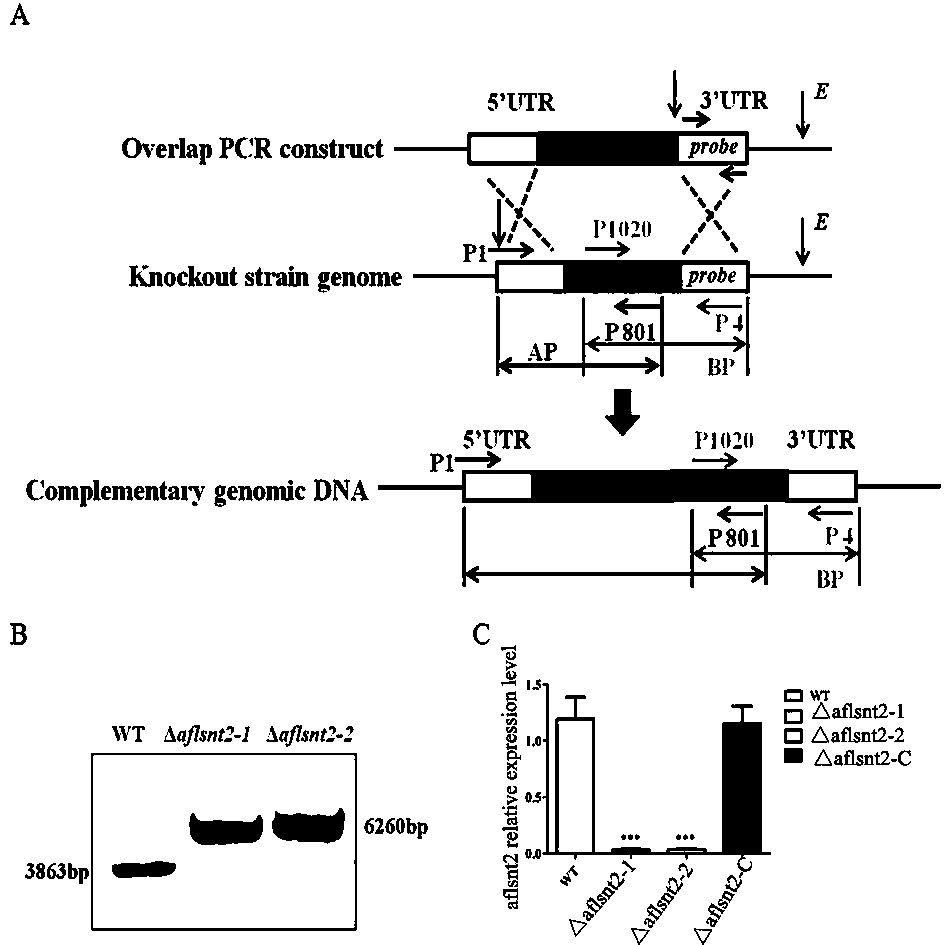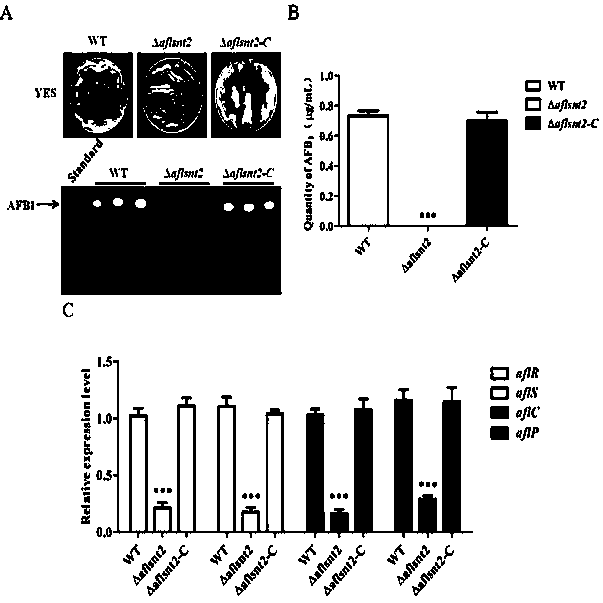Strain Delta Aflsnt2 which does not produce aflatoxin and application in aspergillus flavus prevention and control
A technology of aflatoxin and bacterial strains, applied in the field of microbiology, can solve the problems of unknown and pathogenicity of Aspergillus aflatoxin, and achieve the effects of cost reduction, infection rate of toxin-producing Aspergillus aflatoxin, and pollution control
- Summary
- Abstract
- Description
- Claims
- Application Information
AI Technical Summary
Problems solved by technology
Method used
Image
Examples
Embodiment 1
[0044] Embodiment 1, in Aspergillus flavus aflsnt2 gene knockout
[0045] Aspergillus flavus aflsnt2 Gene function in Aspergillus flavus morphogenesis and virulence expression, first knockout in Aspergillus flavus aflsnt2 Gene.
[0046] figure 1 A shows the strategy for gene knockout. in vitro construction aflsnt2 Gene knockout fragments, through the method of homologous recombination, the chromosome aflsnt2 The 3.5 kb DNA fragment in the gene was used Afpyr replacement, thereby knocking out the chromosomal aflsnt2 Gene.
[0047] The specific method is as follows:
[0048] Using the 5' primer CTTCTCGAATTCCCCTTCATGACACTCTCC (SEQ ID NO: 3); and the 3' primer GCTAAATCAGGATGGGTTGGAGGGTGAC (SEQ ID NO: 4); the upstream fragment of about 1.2 kb was amplified by PCR from the genomic DNA of Aspergillus flavus CA14 strain;
[0049] Using the 5' primer GTCACCCCTCCAACCCATCCTGATTTAGCGCCTCAAACAATGCTCTTCACCC (SEQ ID NO: 5); and the 3' primer ACACGGTCCAAACAACACAAAGGAGATGCGTC...
Embodiment 2
[0052] Embodiment 2, aflsnt2 The Effect of Gene Knockout on Sporulation of Aspergillus flavus
[0053] Knockout in Aspergillus flavus by homologous recombination aflsnt2 Gene, Southern blot analysis confirmed that the knockout was successful. to detect aflsnt2 Whether the deletion of the gene will affect the spore production of Aspergillus flavus, the inventors placed it on the PDA medium at 37°C ( figure 2 A) Cultivate in the dark for 5 days, and observe the sporulation of the following strains. Compared with wild-type strain WT and anaplerotic strain, ⊿ aflsnt2 The number of green spores produced by the strain was significantly reduced, as indicated by the statistical analysis of the data ( figure 2 B).
[0054] This result shows that, aflsnt2 Gene deletion affects sporulation in Aspergillus flavus.
Embodiment 3
[0055] Embodiment 3, aflsnt2 Effect of gene knockout on toxin production of Aspergillus flavus
[0056] to detect aflsnt2 Whether the deletion of the gene can affect the toxin production of Aspergillus flavus, the inventor inoculated the spores to a final concentration of 10 in the YES liquid medium. 6 cells / ml, cultured statically for 6 days under continuous dark conditions at 29°C, extracted the toxin, and analyzed the toxin production of each strain by TLC. The results showed that the WT strain produced a large amount of aflatoxins AFB1 and AFB2, while ⊿ aflsnt2 AFB1 and AFB2 are obviously not produced, and the statistical analysis of the data also shows this ( image 3 A, 3B).
[0057] The inventors simultaneously detected the regulatory genes of the aflatoxin biosynthesis pathway by qRT-PCR R and AfllS , and some structural genes AfllC and AfllO the transcription level of actin As an internal control for transcriptional analysis. Compared with the WT strai...
PUM
 Login to View More
Login to View More Abstract
Description
Claims
Application Information
 Login to View More
Login to View More - R&D
- Intellectual Property
- Life Sciences
- Materials
- Tech Scout
- Unparalleled Data Quality
- Higher Quality Content
- 60% Fewer Hallucinations
Browse by: Latest US Patents, China's latest patents, Technical Efficacy Thesaurus, Application Domain, Technology Topic, Popular Technical Reports.
© 2025 PatSnap. All rights reserved.Legal|Privacy policy|Modern Slavery Act Transparency Statement|Sitemap|About US| Contact US: help@patsnap.com



